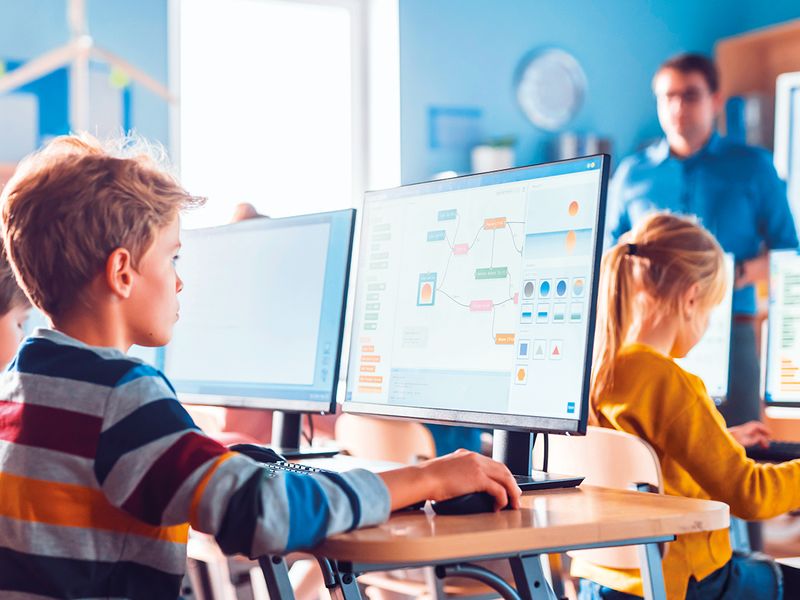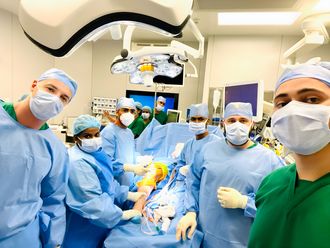
Highlights
Explore how schools in the UAE are leading the charge with cutting-edge technology, making learning more personalised and immersive than ever before
In today’s rapidly evolving technological landscape, education is not just keeping up but leaping ahead, transforming traditional classrooms into dynamic environments filled with advanced tools and immersive experiences. The shift from static learning methods to interactive, tech-driven approaches marks a significant departure from conventional teaching styles, promising a future where learning is more personalised, engaging, and effective.
Forget the dusty chalkboards and static desks — education is leaping into the future with cutting-edge technology and interactive learning methods. Traditional classrooms are being revolutionised by AI and VR, offering students a more personalised and engaging educational experience. Dr. Neil Hopkin, Director of Education at Fortes Education, is leading this charge, demonstrating how tech is seamlessly integrated into everyday learning to reshape the educational landscape.
Fortes Education’s approach to AI is about much more than just adopting new tools; it’s about transforming how education is delivered. “We’ve taken a proactive stance towards AI in education,” Dr. Hopkin explains. AI at Fortes Education is used to enhance rather than replace traditional teaching methods. According to Dr. Hopkin, “AI enables targeted planning that reacts to student performance data and helps students leverage its power to better inform their explorations and creations.” Research supports this approach, indicating that AI tools that complement conventional methods are more effective in boosting student achievement.
The integration of AI allows for personalised learning experiences that cater to individual student needs. A recent study from Educational Technology Research and Development highlights that AI-driven platforms can significantly boost student engagement and performance by adapting content based on real-time data. Dr. Hopkin emphasises that AI augments conventional learning pathways, creating a richer educational environment. This perspective aligns with findings from the Journal of Educational Technology & Society, which suggest that AI tools, when used to support rather than replace traditional methods, enhance student outcomes.
Virtual reality (VR) is another transformative technology at Fortes Education. VR headsets transport students to places that are otherwise inaccessible or too expensive to visit. “We use VR headsets to explore distant terrains like the moon or the Amazon Rainforest,” Dr. Hopkin says. This immersive technology offers a sensory-rich experience that traditional methods can’t match. VR also allows students to explore micro spaces, such as blood vessels or the heart, providing a hands-on approach to complex subjects.
VR ENHANCES LEARNING OUTCOMES
The impact of VR on education is backed by research, with studies published in Computers & Education showing that VR significantly enhances learning outcomes by providing interactive and immersive experiences. “VR allows students to delve into micro spaces like blood vessels or the inner workings of the heart,” Dr. Hopkin adds. This approach helps bridge the gap between theoretical knowledge and practical understanding, making abstract concepts more tangible.
However, integrating new technologies into the classroom isn’t without challenges. Dr. Hopkin notes that successful technology adoption requires careful planning. “Successful technology adoption requires two key elements,” he says. First, teachers need a risk-free environment to experiment with new tools. “Teaching staff need the opportunity to experiment in a risk-free environment where they can freely fail, learn, unlearn, and re-learn,” Dr. Hopkin explains. This approach allows educators to explore and adapt to new technologies without the fear of failure.
The second critical element is involving students in the technology adoption process. “Digital natives are powerful advocates and critics of technology,” Dr. Hopkin notes. Engaging students in the integration process helps ensure that new tools meet their needs and addresses any issues they might have. Research from Technology, Pedagogy and Education supports this approach, indicating that involving students in the technology adoption process leads to higher satisfaction and better outcomes.
Dr. Hopkin’s insights reflect a broader trend where technology is used not to replace traditional methods but to complement and enhance them. As educational institutions continue to explore these innovations, the focus remains on creating environments where technology and traditional methods work together to provide a richer, more engaging educational experience.
Raffles World Academy’s Principal, Timothy Roberts, offers additional perspectives on these transformative practices. “At Innoventures Education, we recognize the transformative potential of AI-driven personalised learning tools in shaping the future of education,” Roberts shares. His school’s approach integrates AI across various aspects of the curriculum, tailoring learning experiences to the unique needs and learning styles of each student. “We have been using platforms like adaptive learning software and intelligent tutoring systems to create individualized learning paths that allow students to progress at their own pace,” Roberts explains.

The impact on student engagement and academic performance at Raffles World Academy has been significant. “We’ve observed higher levels of motivation among students, as they receive real-time feedback and personalised resources that address their specific areas of need,” Roberts notes. For instance, students struggling with particular concepts receive targeted practice, while those who excel are offered advanced challenges. This approach not only enhances academic performance but also fosters a love for learning.
Roberts also highlights the role of VR in transforming traditional teaching methods. “Virtual reality (VR) and other immersive technologies have revolutionized the way we approach teaching,” he says. VR allows students to explore ancient civilizations or witness complex scientific phenomena interactively. “For example, our students can take virtual field trips to historical sites or dive into the microscopic world,” Roberts adds. This hands-on approach increases engagement and improves retention of complex information.
TAKING ON CHALLENGES
However, adopting new technologies presents challenges. “One of the main challenges we faced was the initial resistance to change,” Roberts admits. To address this, Raffles World Academy implemented a comprehensive professional development program, including training sessions and workshops for teachers. “We also provided opportunities for peer-to-peer learning,” Roberts explains. For students, new technologies were gradually integrated, and parents were involved through workshops and resources to support their children’s learning journey.
Gender diversity in technology adoption has also been a focus at Raffles World Academy. “By promoting initiatives such as Girls Who Code, we are working to close the gender gap in STEM fields and empower all our students,” Roberts says. This strategic approach — grounded in professional development, sustainability, and inclusivity — has enabled a smooth transition for both teachers and students.
While Fortes Education and Raffles World Academy are leading the charge in educational innovation, other institutions are also making significant strides. Saba Adnan, Director of Innovation in Teaching, Learning & Curriculum at GEMS Founders School – Al Mizhar, has been pivotal in integrating AI-driven personalised learning tools into the curriculum. “Our commitment to innovation led us to integrate AI tools like Quizzes, which help students create personalised revision quizzes,” says Adnan. This AI-driven tool adapts to individual student needs, significantly enhancing engagement and academic performance.
Adnan also discusses the challenges encountered in adopting these technologies, such as Professional Development (PD) time and teacher buy-in. “To address these challenges, we introduced bite-sized PD sessions that fit into teachers’ schedules, allowing them to build their skills gradually,” Adnan explains. Additionally, integrating AI technologies within existing curriculum projects, like the Take One Picture project and Innovation Challenges, has fostered enthusiasm among teachers and students alike. This approach aligns with the school’s Core Framework #THEGFMWAY, promoting growth and development for all stakeholders and ensuring a smoother transition to new tools.
Similarly, Rishika Malhotra, Head — Raffles Early Childhood Education, Innoventures Education, highlights the integration of AI in early education. “We’ve embraced AI by incorporating interactive robotics games into free play activities,” says Malhotra. This approach fosters curiosity and creativity while strengthening classroom bonds. Malhotra emphasises that AI-driven play helps children build competence and confidence, preparing them for a tech-savvy future. “Our fusion of traditional play with modern AI technology makes learning exciting and dynamic,” she adds.











